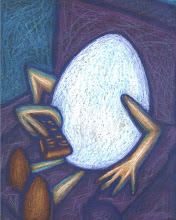It's Hot!
It's Hot!
I created this watercolor in a cartoon-like (illustrative or animated would be a more proper term) style simply because I wanted to show off the beautiful features in the desert. One of my favorite quotes you can find in Frank Herbert's, Dune:"Wisdom comes from the desert and polish comes from the city."
I believe in this quote because of the strong spiritual feeling I get when walking across the desert. I've visited the Chihuahan Desert, the Mojave Desert and the Sonoran Desert in my travels and I'm always in awe by the extreme temperatures, wildlife and landscape.
I've included a vulture in this picture because I really love the turkey vulture. I have looked up the difference between a vulture and a buzzard many times and all the dictionaries and encyclopedias argue on the proper definitions and differences. Basically, here in the United States there is a difference which has to do with how they eat, (carrion or prey) and what bird they have evolved from (eagle, falcon or hawk). In Europe, there is no difference and most believe that is how we picked up the term buzzard.
Whether you disagree with my summation or not, you must agree this is an incredible bird in both wingspan and resilience. Vultures and buzzards play a major role in our environments. Many have labeled them "nature's environmentalists." Imagine how messy it would be if we didn't have this animal to clean up all the carcases in the desert! The ancient Egyptians believed the vulture carried your soul to the heavens. This is why you see the ancient hieroglyphs with vultures worked in the glyphs. One of the oldest Egyptian gods, Nekhbet, is symbolized as a vulture.
The vulture has taken on bad PR in the past. In some parts of the US they are considered pests because they would attack small farm fowl but that is a buzzard (by most definitions because a vulture feeds on carrion - dead animals, not live prey.) This is why I choose the term vulture when referencing any great scavenger bird out of respect for such a magnificent animal that's capable of surviving in such extreme temperatures all over the world.















